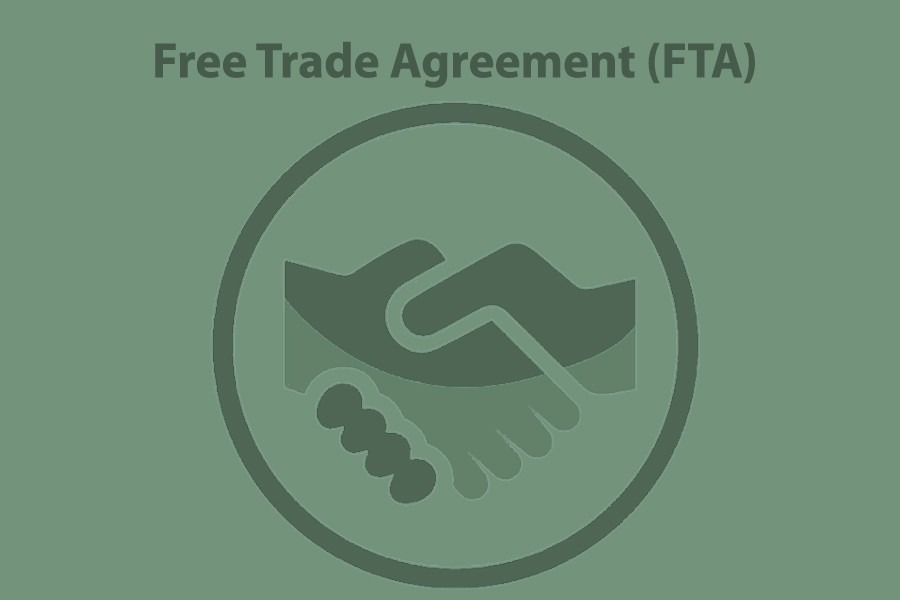
Published :
Updated :

Bangladesh's eagerness to sign free trade agreements (FTA) with various trade partners is known. To recover the erosion of preferences like duty-free quota-free market access in the post-LDC era, signing bilateral and regional FTAs is now critical. The policymakers also recognise the necessity. Still, there is a dilemma in signing a bilateral FTA (BFTA) and the country has yet to sign any BFTA, except for a preferential trade agreement (PTA) with Bhutan. Even if the dilemma goes, several barriers to striking a win-win FTA need to be addressed.
A government study estimated that Bangladesh would lose US$ 7.0 billion in export revenue in 2027 after graduating from the Least Developed Country (LDC) category in 2026. After graduation, different trade and tariff preferences will no longer exist as those are exclusively for LDCs. So, the initial shock will be a loss in export earnings due to higher tariffs and stiff competition. It is not guaranteed that FTAs will fully compensate for the loss. What is essential is exploring various markets through free trade deals, as it will take time to get the desired outcome.
The first barrier to signing an FTA is that Bangladesh neither has adequate capacity, nor experience on strong trade negotiations and signing comprehensive FTAs. The fact is also recognised in the 'Impact Assessment and Coping up Strategies of Graduation from LDC Status for Bangladesh', prepared by the planning commission three years back. Thus, enhancing trade negotiating capacity in both the public and private spheres is necessary. Already, the government has taken some measures, and more is expected to come.
Another big barrier to striking a BFTA is the apprehension of a reduction in customs duty at the import stage due to tariff concession to the FTA partner country. Around 11 per cent of the country's total revenue comes from customs duties or import tariffs. The cut in income from the source will create extended pressure to offset the loss from domestic sources. The concern about a cut in import revenue largely holds back advancement in any FTA deal. Nevertheless, it will not be possible to rely on customs duty as a significant source of revenue in the near future.
Now, it also appears that the authorities have started to give up the conservative approach so that revenue issue does not become a barrier to signing an FTA. The first tariff policy of the country, adopted last month is a clear indication in this regard. It underscores the reduction of the protective tariff gradually and simplifies the overall tariff regime. Overall, the tariff policy mentions that tariffs should be considered a critical tool of the country's trade policy and not an instrument of revenue generation.
The existing gap between the bound and applied tariff rates also gives a misleading message to the trade partners. The country's simple average final bound tariff rate is 156.30 per cent, while the most favoured nation (MFN) rate was 14 per cent in 2021. Some may think that though the country generally imposes a lower tariff rate, it can enhance it to as high as 150 per cent or more at any time. The ample policy space for tariff escalation needs to be reconsidered to make the tariff regime more predictable.
Besides the tariffs, non-tariff measures (NTMs) also require review and adjustment to create adequate space for FTA negotiations. So far, there is an attitude that the leading trade partners have used various NTMs to make the imports from Bangladesh challenging or complex. The opposite is also true and needs to be recognised fully. NTM Business Survey 2014-2015, conducted by the Geneva-based International Trade Centre (ITC), showed that there exists some regulatory and procedural obstacles to two-way trade with Bangladesh. Almost a decade later, things have improved in many areas, although there is room for further improvement.
As the patterns of FTA have already changed where tariffs and trade in goods are not the only priority, NTMs, including standards have emerged as an essential dimension. Moreover, NTMs are not imposed by the governments arbitrarily. The firms in the global value chains set the various standards and compel the respective governments to take different NTMs. So, understanding domestic and external NTM is a must while negotiating an FTA. Keeping the own NTMs stringent and complex in the name of protecting local industry or consumer welfare is not helpful for striking a win-win FTA with other countries. As the issue of NTM is tricky, it requires deep examination for adjustment.
FTA is also a tool for integration in the global economy. The 'World Trade Report 2023: Re-Globalisation for a Secure, Inclusive and Sustainable Future', released by the World Trade Organization (WTO) last week in Geneva, said: "Open trade, supported by a robust multilateral trading system, serves as a key driver of economic security by enabling firms and households to access alternative options when faced with supply shortages." It also argued that more open trade and deeper integration have contributed to reducing poverty.
The more a country integrates with the rest of the world, the more it has the scope to tap various benefits and not without risks. So, FTA is also not a panacea. An FTA may drive domestic industries to improve competitiveness, rely less on government support, open new markets, and invite new investments. At the same time, there are risks of disruptive competition and loss of traditional livelihoods with a negative impact on jobs. That's why it is necessary to rigorously negotiate an FTA deal with another country so that the risks could be minimised in the long run.


 For all latest news, follow The Financial Express Google News channel.
For all latest news, follow The Financial Express Google News channel.